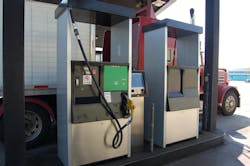Another week, another spike in fuel prices, with average U.S. retail pump prices for diesel climbing 5.3 cents to $4.157 per gallon – 19.7 cents per gallon higher than the same period in 2012 – while gasoline jumped a whopping 13.6 cents to $3.747 per gallon; some 15.6 cents higher per gallon compared to the same week last year.
The Energy Information Administration (EIA) reported that prices for both diesel and gasoline increased in every region of the country this week, with the highest spikes for diesel along the Gulf Coast (a 7.1 cent per gallon jump), with New England and the Rocky Mountains both recording a 6.8 per gallon increase.
Diesel is now over $4 per gallon across the U.S., according to EIA’s data, with California home to the highest diesel prices in the country – $4.361 per gallon – with New England ($4.334) and the Central Atlantic region ($4.254) second and third, respectively.
Gasoline price increases ran to double digits across much of the U.S., the agency reported, with the Midwest suffering the highest price surge for the week at 18.1 cents per gallon, followed by the Central Atlantic region (15.6 cents) and Gulf Coast (15 cents).
The price for gasoline in the U.S. this week is highest on the West Coast, averaging $3.973 per gallon, followed by New England ($3.798) and the Central Atlantic region ($3.776).
AAA noted that gasoline is now 44 cents per gallon more costly compared to one month ago, with the 44-cent month-over-month increase the most dramatic since June 2009. The largest increase on record was August 5-September 4, 2005 when prices jumped 75 cents largely because of Hurricane Katrina, the group noted.
AAA added that the national average for gasoline has now increased for 33 consecutive days, rising 46 cents or nearly 14 percent during this stretch – the longest streak since the price increased 44 cents over 44 days between March 22 and May 5 in 2011. “This year’s run-up is not only larger and faster than recent years but is beginning earlier,” the group pointed out. “The national average in 2011 increased by just seven cents during the same 33 day period and in 2012 it increased by 18 cents.”
There are several reasons being posited for the steep run-up fuel prices this year, such as the shutdown of U.S. refineries for seasonal maintenance and to switch-over to making summer blend gasoline production earlier in the year.
“This earlier schedule is the choice of refiners and has not come in response to any change to the deadline to complete the transition to summer-blend fuels, which are required in many parts of the country and more expensive to produce,” AAA said. “Regional supplies can decrease when refineries go offline and subsequently markets are more sensitive during the changeover period to refinery disruptions that would further squeeze supply, as we have seen this year.”
Still, the EIA for one expects the current spike in fuel prices to eventually moderate as 2013 progresses. The agency still expects Brent crude oil spot prices to average $109 this year – compared to average of $112 per barrel in 2012 and $119 per barrel in early February 2013 – with the projected discount for West Texas Intermediate (WTI) crude oil to drop to $9 per barrel in 2014 from an average $18 per barrel in 2012, as planned new pipeline capacity lowers the cost of moving midcontinent crude oil to the Gulf Coast refining centers.
As a result, EIA expects that eventual drop in crude oil prices will contribute to a decline in the national annual average regular gasoline retail price from $3.63 per gallon in 2012 to $3.55 per gallon in 2013 and $3.39 per gallon in 2014, though that’s roughly 11 cents per gallon and 4 cents per gallon higher, respectively, than forecast in agency’s short term energy outlook last month.
Retail prices for diesel should also fall by year's end, EIA noted, dropping to to $3.92 per gallon in 2013 and to $3.82 per gallon in 2014 compared to $3.97 per gallon in 2012.
About the Author
Sean Kilcarr
Editor in Chief
Sean Kilcarr is a former longtime FleetOwner senior editor who wrote for the publication from 2000 to 2018. He served as editor-in-chief from 2017 to 2018.
